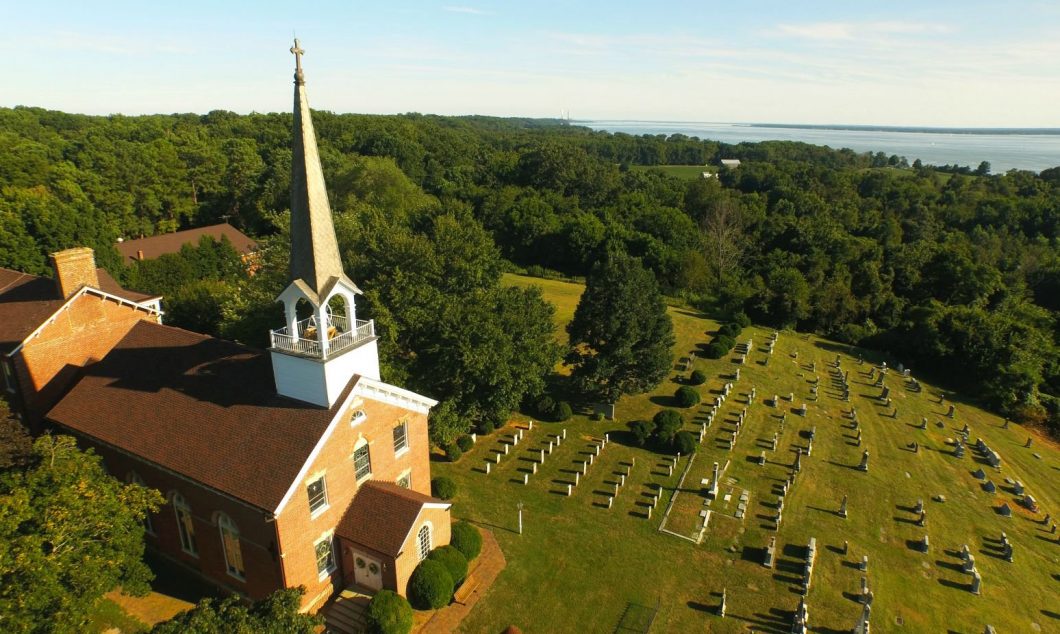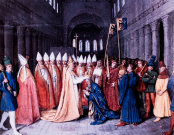Did Catholics Establish Religious Liberty in America?
From the earliest colonial settlements to the founding era, the vast majority of white Americans were Protestants (98% in 1776). Many of these Protestants considered the Roman Catholic Church to be benighted, if not in league with Satan. Catholics were banned from many colonies, and men and women desiring to immigrate to British North America were expected to take explicitly Protestant oaths before doing so.
Maryland was founded in 1632 as a haven for English Catholics. But even in its earliest days, Catholics were a minority. Protestants eventually took control of the colony, made the Church of England the established church, and banned Catholics from voting and holding political office.
Our Dear-Bought Liberty: Catholics and Religious Toleration in Early America, by Michael D. Breidenbach, traces why and how Catholics have advocated for their own religious freedom in America, and their contributions to the ability of all citizens to worship God according to the dictates of conscience. The author highlights the roles two families played in these debates: the Calverts and the Carrolls.
The Calverts and Religious Toleration
When Pope Clement VII refused to annul King Henry VIII’s marriage to Catherine of Aragon, Henry encouraged Parliament to pass a series of laws which, among other things, declared him to be the “Supreme Head on earth of the Church of England.” Pope Clement and later popes were not amused. Indeed, they asserted that they had ecclesiastical authority in England and possessed the power to depose monarchs.
To ensure that English citizens were loyal to the crown, in 1606 King James I required them to swear an Oath of Allegiance that acknowledged that he “was the lawful king of England and the pope did not have the power to depose him . . .” As well, they had to swear that they “abhor, detest and abjure, as impious and heretical, this damnable doctrine and position, that princes which be excommunicated or deprived by the Pope, may be deposed or murdered by their subjects or any other whatsoever.”
Despite what many Protestants believed about “papists,” there were serious debates among Roman Catholics regarding two key issues. Catholics influenced by the conciliarist tradition, a reform movement within Catholicism dating back to the fourteenth century, rejected the doctrine of papal infallibility, although adherents believed that a general council of Catholic bishops, which might but did not have to include the pope, could speak with such authority. Catholics in this tradition also denied that the pope could depose monarchs.
George Calvert (1580-1632) was born a Roman Catholic, but was forced to conform to the Church of England. He eventually became an important advisor to James I. In 1624, he returned to the Catholic Church and determined that he could not swear the loyalty oath. He did not believe that the pope could remove a monarch, but he hesitated to call something the pope had said to be true “damnable” and “heretical.”
In 1632, Calvert received a charter from Charles I to found the colony of Maryland. Under the leadership of George’s son Cecil, the colony required citizens only to swear loyalty to the crown, simply avoiding those parts of the 1606 Oath of Allegiance that Calvert and others found to be objectionable.
The Maryland Assembly passed “An Act Concerning Religion” in 1649, one of the first religious toleration acts ever adopted. The law stipulated that all Trinitarian Christians are free to worship God according to the dictates of conscience. Despite the pleas of Jesuit priests in the colony who thought the Catholic Church should be made the official established church, Calvert decided to have no established church. Historians often describe these acts as purely pragmatic ones, and Breidenbach acknowledges that Maryland’s civic leaders had prudential concerns. But he also shows that these decisions were a result of the influence of the conciliar tradition.
During the English Civil War, some of Maryland’s Protestants, who constituted three-quarters of the colony’s population, took up arms against Cecil Calvert and, later, Charles Calvert. After the Glorious Revolution of 1688, Protestants gained control of the colony and made the Church of England the “de facto established church in Maryland in 1692 and the de jure established church in 1702.” Beginning in 1715, the Calverts conformed to the Church of England so as to maintain their proprietorship.
The Carrolls, Toleration, and Revolution
Charles Carroll the Settler came to Maryland in 1688, shortly before the Protestants took control of the colony and placed numerous restrictions on Catholics. He and his descendants, beginning with his son, Charles Carroll of Annapolis, fought long and hard for religious liberty and political equality. Like the Calverts, they were influenced by the conciliarist tradition and were averse to what they considered to be tyrannical forms of governments, whether civil or ecclesiastical. Indeed, en route to Maryland, Charles the Settler changed his family motto to “Ubicu[m]que cum Libertate” (anywhere so long as there be freedom).
Freedom for Catholics was severely limited in Maryland. In 1692, they were barred from practicing law, and in 1704 the legislature prohibited priests from proselytizing or celebrating Mass. The latter act was repealed in 1718, but other restrictions and penalties remained in place—including a fine of £100 on parents who sent a child to Catholic schools in Europe. Catholics were unable to vote in civic elections from 1718 to 1776.
When Charles Carroll of Carrollton was a student in France, he penned a poem “defending the free exercise of religion in the face of state tyranny.” A conciliarist, he argued that papal infallibility was an “opinion” of the Council of Trent that good Catholics could reject. Committed to liberty for white Americans (but not enslaved Africans who were central to the Carroll family’s wealth), he was an active supporter of the War for American Independence.
American Protestants were alarmed when Parliament adopted the Quebec Act in 1774. The statute tolerated the Roman Catholic Church and extended the colony of Quebec into what is now the upper-Midwest. Many American Protestants, including representatives serving in the Continental Congress, objected vehemently. The Quebec Act was condemned in a number of official Congressional proclamations and petitions.
When the Constitutional Convention met in the summer of 1787, eight states required civic office holders to be Protestants. And yet Article VI of the new federal constitution prohibited religious tests for civic office.
In 1776, Congress appointed Charles to be a member of a committee that was to go to Quebec and encourage the French Catholic population to join the patriot cause. At Congress’s urging, Charles asked his cousin the Reverend John Carroll to join the commission. John was disinclined to join the commission because he was a priest, but he relented and the group traveled to Quebec. Unfortunately for the patriots, the venture was an utter failure.
After Quebec, Charles joined the Second Continental Congress, the first Catholic to so serve. He later signed the Declaration of Independence. Catholic Americans fought in the Continental Army and the state militia, and some commanded troops and ships. Catholic participation in the War for American Independence, along with aid from Roman Catholic France, helped many Protestants to be far more accepting of their fellow citizens.
Catholics and America’s Constitutional Order
When the Constitutional Convention met in the summer of 1787, eight states required civic office holders to be Protestants. And yet Article VI of the new federal constitution prohibited religious tests for civic office. Charles Carroll’s second cousin Daniel Carroll, and Thomas Fitzsimons of Pennsylvania, undoubtedly supported this prohibition. The first federal Congress, which included Daniel Carroll and Fitzsimons in the House of Representatives and Charles Carroll in the U.S. Senate, passed an inclusive loyalty oath which required those taking it merely to swear (or affirm) to support the Constitution of the United States.
Not surprisingly, Congress’s Catholic members were in favor of what became the First Amendment, and Charles Carroll was one of three senators on the conference committee that brought the Bill of Rights into its final form. Far too many academics act as if the First Amendment sprang fully formed out of James Madison’s brow. Breidenbach does an important service in reminding us that other founders played important roles in crafting this and other amendments, and that they were informed by traditions that predate John Locke. But he goes too far when he describes Carroll as the First Amendment’s “godfather.”
By the 1790s, Catholics were widely accepted and states were beginning the slow process of removing religious tests that prevented them from holding state offices. But, as Breidenbach briefly recounts, the 19th century saw great waves of Catholic immigrants, many of whom were ultramontanes who rejected the conciliarist tradition. Moreover, the Catholic Church decisively renounced this tradition as the 19th century unfolded. In this period, popes issued numerous encyclicals that denounced religious liberty, separation of church and state, republicanism, and freedom of the press. In 1870, the First Vatican Council declared papal infallibility to be an official dogma of the Church. These shifts rekindled Protestant fears that Catholics could not be good citizens and led to new manifestations of anti-Catholicism.
Our Dear-Bought Liberty is the definitive treatment of the Catholic quest for religious toleration in America from early colonial Maryland to the creation of the American republic. Breidenbach demonstrates that leading American Catholics were influenced by conciliar thought, not simply making prudential compromises or accepting Protestant or Lockean ideas.
Breidenbach grounds his arguments in a detailed and exhaustive examination of the relevant primary source documents. His account is careful and nuanced, although upon occasion he overstates the influence of his subjects such as when he writes that Catholics played a “critical role . . . in establishing American church-state separation.” Catholics played a role, to be sure, yet it is hard to imagine that American approaches to church-state relations would have been significantly different had the Calverts and Carrolls never come to America.
But such overstatements are rare. On balance, Our Dear-Bought Liberty is an excellent work that should be read by anyone interested in church-state relations in early America.


